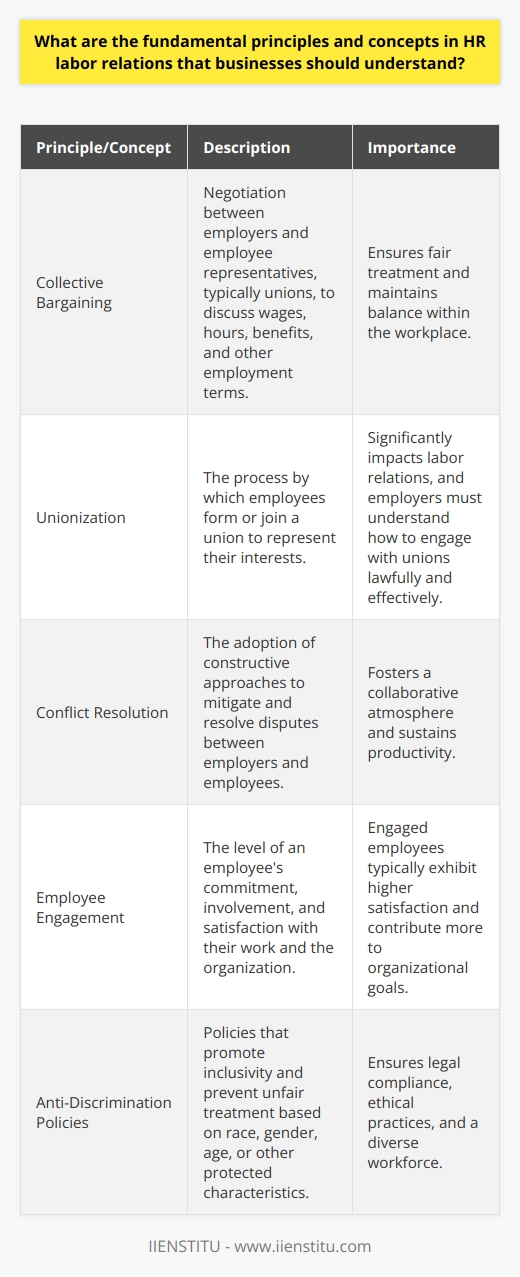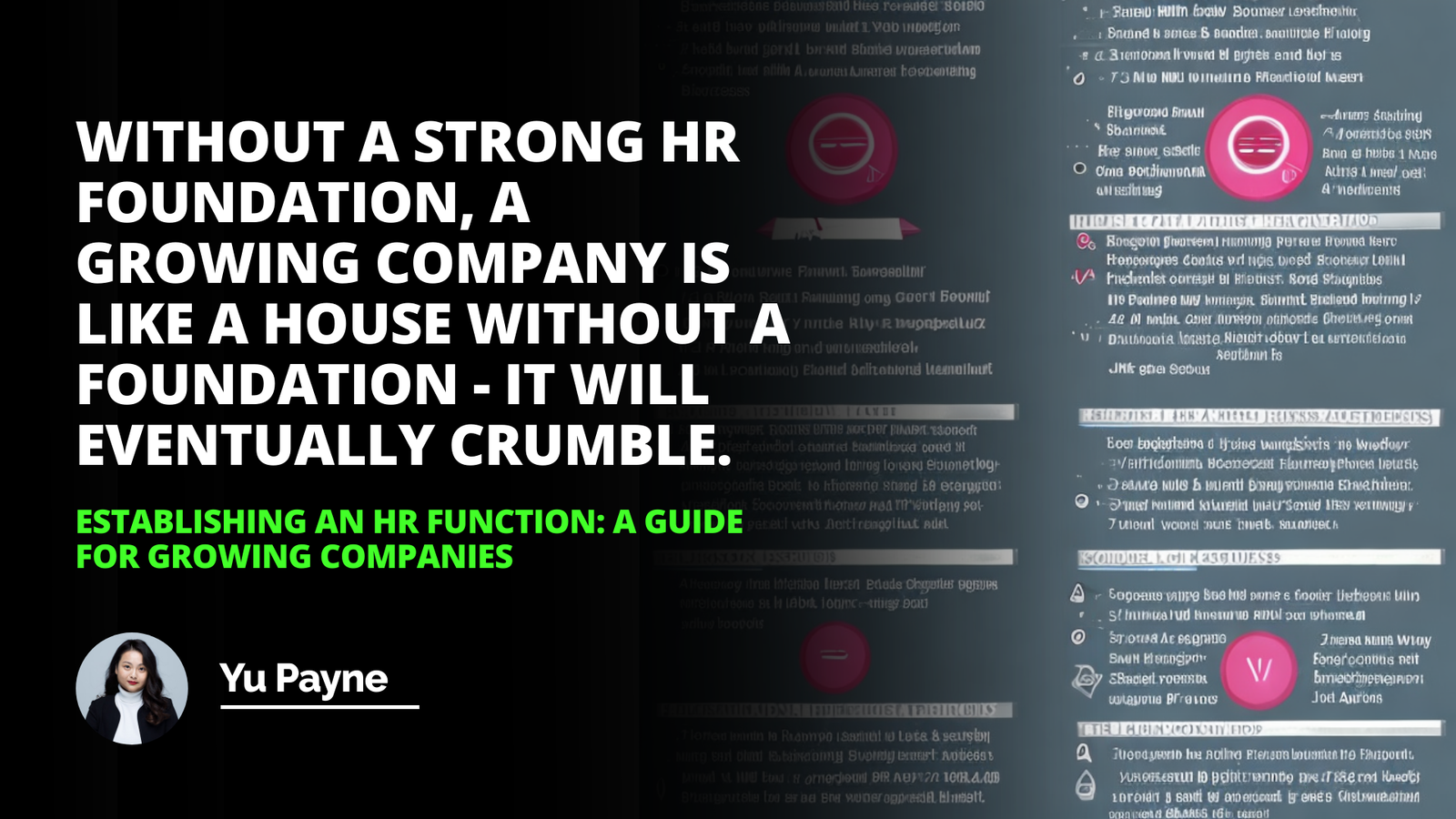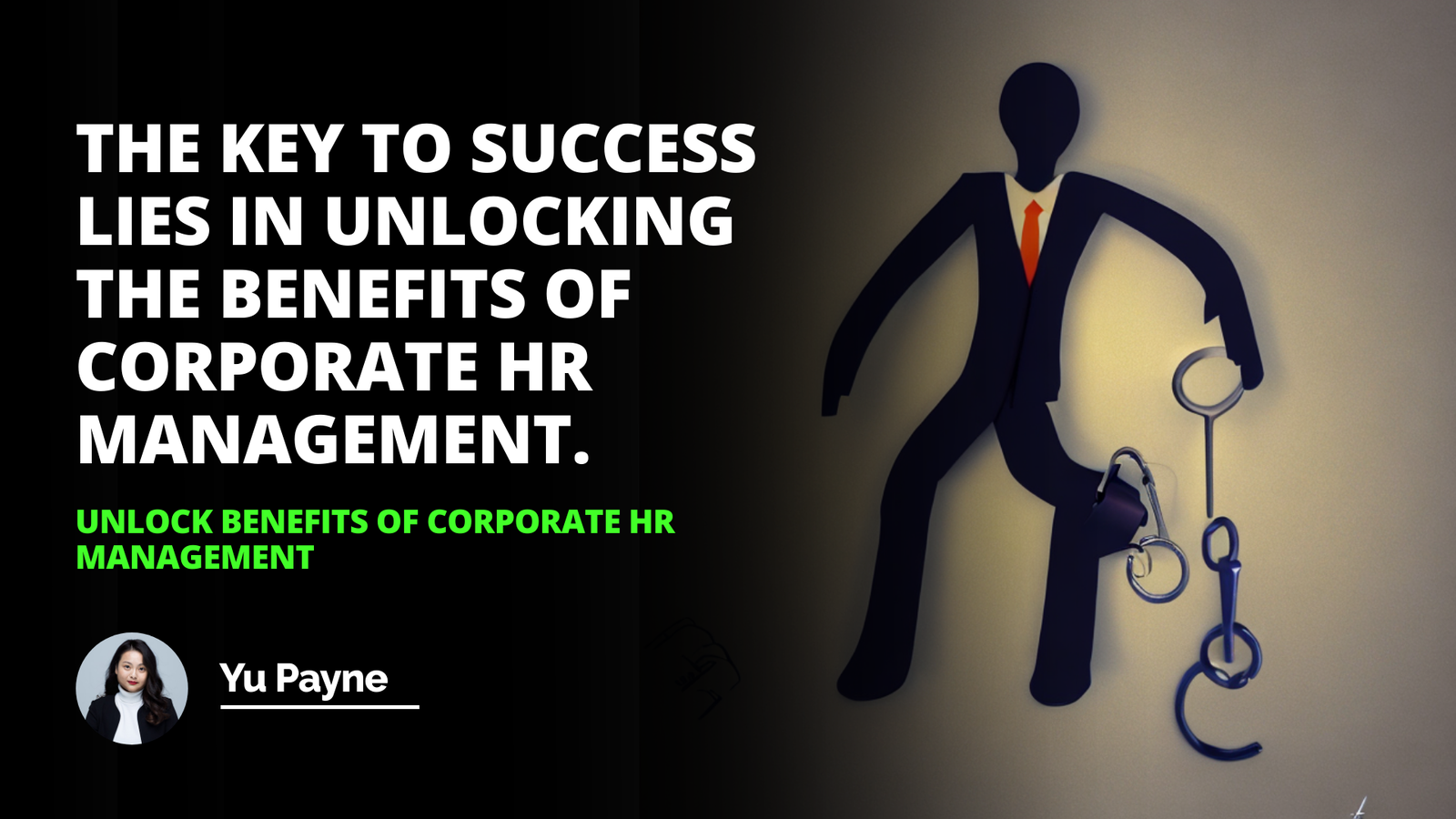
Human Resources (HR) labor relations training plays an integral role in fostering a harmonious workplace environment, where both employees and employers understand their rights and responsibilities. This type of training is paramount in modern companies for navigating the complex legal landscape of employment law while also promoting fair and equitable practices within organizations.
Throughout this article, we will delve into the essence of HR labor relations training, examine its pivotal components, and dissect how it impacts the overall productivity and culture of a business. By endowing HR professionals with a comprehensive knowledge base and developing their skill sets, companies can ensure compliance with labor laws and cultivate a supportive workplace dynamic.
Understanding HR Labor Relations
Explanation of HR Labor Relations
The field of HR labor relations encompasses the management of interactions between employers and employees, including negotiations, collective bargaining, grievance handling, and compliance with employment standards.
An effective labor relations strategy can serve as the backbone of a company, ensuring a balanced approach to addressing various personnel and policy issues. Labor relations cover a myriad of areas, from equitable payroll and benefits management to upholding workplace safety and ethical standards. Its depth and breadth necessitate a strong foundation of knowledge, bolstered by HR training for those tasked with its oversight.
Roles and Responsibilities of HR in Labor Relations
HR professionals occupy a central role in labor relations, acting as mediators and policy enforcers within a company. They are instrumental in dispute resolution, working to prevent escalations and developing fair outcomes for employee grievances.
Furthermore, HR departments are responsible for the creation, implementation, and enforcement of company policies that align with labor legislation and ethical work practices. This comprehensive involvement ensures that procedures and regulations are adhered to and that the rights of workers are respected, promoting a stable work environment.
Main Components of HR Labor Relations Training
Reviewing Labor Laws and Regulations
To navigate the often-complex legalities of labor relations, HR professionals must be well-versed in employment law. Online certification courses and other hr training resources enable these individuals to acquire the knowledge of federal, state, and local laws that govern everything from wages and working hours to discrimination and harassment. Legal knowledge in HR serves as a protective barrier against inadvertent non-compliance and possible litigation, thereby safeguarding the company’s interests.
Enhancing Communication Skills
Effective communication is paramount in labor relations, as clear and transparent dialogue facilitates better understanding and cooperation between employers and employees. HR training often includes modules aimed at enhancing communication skills, teaching professionals how to convey complex information clearly, manage sensitive conversations, and listen actively. With well-honed communication abilities, HR professionals can more effectively manage workplace relationships, mitigate conflict, and uphold a positive organizational culture.
Conflict Resolution Training
Conflict is a natural occurrence in any workplace, but how it is addressed can determine the health and efficiency of an organization. Through HR training, professionals learn strategic approaches to conflict management, such as interest-based negotiation and mediation. Learning from case study examples, HR trainees can acquire the skills necessary to de-escalate tension, find common ground, and implement long-term resolutions that align with company values and labor laws.
The Impact of Effective HR Labor Relations Training
Boosting Workplace Productivity
Investments in HR labor relations training can lead to tangible boosts in workplace productivity. By implementing effective labor relations strategies, HR professionals help create an environment where employees feel heard and valued, which can translate to increased motivation and output. Statistics support the correlation between effective labor relations practices and enhanced productivity, indicating that this training has a direct impact on a company’s bottom line.
Strengthening Employee-Employer Relationships
One of the core outcomes of HR labor relations training is the reinforcement of employee-employer relationships. A transparent HR approach that prioritizes effective communication helps in building trust, which is fundamental for long-term engagement and retention. Strong employee-employer relationships often result in higher job satisfaction, reduced turnover, and better organizational performance, demonstrating the significant influence of well-trained HR professionals.
Case Studies of Successful HR Labor Relations Training Programs
Detailed Analysis of Successful Programs
While theory and principles provide a necessary foundation, analyzing successful HR labor relations training programs offers concrete insights. These case studies reveal the strategies used by various organizations to navigate and resolve labor issues effectively. A thorough examination of such programs sheds light on innovative practices and optimal training methodologies that lead to lasting improvement within an organization.
Lessons Learned and How These Can Be Applied Going Forward
Reflecting on these success stories, HR professionals can distill lessons learned and understand the core principles that drive effective labor relations. Key takeaways include the importance of ongoing education, adaptability to changing labor landscapes, and the cultivation of advanced negotiation skills. Extracting these lessons and applying them forward enables HR teams to stay ahead of industry trends and continue advocating for both employee well-being and company success.
HR labor relations training is undeniably crucial for maintaining a productive, respectful, and legally compliant working environment. From reviewing essential labor laws to fostering positive communication and conflict resolution skills, such training is a cornerstone of modern business operations. As businesses progress, leveraging this training to stay informed and adept in managing workforce dynamics is vital.
Continuous education and upskilling in labor relations not only empower HR professionals but also protect and elevate the companies they serve, ensuring a resilient and harmonious workplace for all.
Frequently Asked Questions
What are the fundamental principles and concepts in HR labor relations that businesses should understand?
Understanding HR Labor Relations
The Basis of Employee Relations
At its core, labor relations revolve around the relationship between employers and employees. This dynamic encompasses various facets, including negotiation, communication, and administration of work-related issues.
The Role of Labor Laws
Labor laws govern this interplay. They ensure fair treatment, protect rights, and maintain balance within the workplace. Businesses must stay abreast of these regulations. They include aspects like minimum wage, overtime, and safe work conditions.
Collective Bargaining
Collective bargaining stands out among labor relations principles. It involves negotiation between employers and employee representatives, typically unions. Parties discuss wages, hours, benefits, and other employment terms.
Unionization
Unionization significantly impacts labor relations. Unions seek to represent employees' interests. Employers must understand how to engage with unions lawfully and effectively.
Conflict Resolution
Conflict resolution serves as a critical component. Employers should adopt constructive approaches to mitigate and resolve disputes. This fosters a collaborative atmosphere and sustains productivity.
Employee Engagement
Employee engagement goes hand in hand with labor relations. Engaged employees typically exhibit higher satisfaction and contribute more to organizational goals. Employers must strive to maintain high levels of engagement.
Fair Labor Standards
Adherence to fair labor standards ensures legal compliance and ethical practices. Standards cover diverse areas from wages to discrimination.
The Importance of Communication
Clear, transparent communication is vital. It builds trust between employees and management. It also heads off potential misunderstandings and disputes.
Ongoing Education and Training
Businesses should invest in continuous education and training. This prepares both management and staff to handle labor relations effectively. It ensures everyone understands their rights and responsibilities.
Anti-Discrimination Policies
Anti-discrimination policies are non-negotiable. They promote inclusivity and prevent unfair treatment based on race, gender, age, or other protected characteristics. Firms should enforce these policies rigorously.
Performance Management
Performance management impacts labor relations. Fair, consistent evaluation systems are necessary. They help manage expectations and provide a basis for rewards and disciplinary actions.
Work-Life Balance
Promoting work-life balance is becoming increasingly important. Employers should consider flexible schedules and telecommuting options. These can lead to better job satisfaction and retention.
Addressing Grievances
A well-defined grievance procedure is crucial. Employees need a mechanism to voice concerns. Businesses should address these grievances promptly and fairly.
Health and Safety Regulations
Compliance with health and safety regulations is essential. They protect employees from harm and employers from legal ramifications.
Technological Advances
Businesses must also account for how technological advances affect labor relations. Automation and artificial intelligence may reshape job roles and demands.
The Global Context
Finally, labor relations do not exist in a vacuum. The global context influences them. Multinational companies must navigate varying labor laws and cultural expectations.
By integrating these fundamental principles and concepts, businesses can establish robust labor relations. This sustains a stable, productive, and harmonious working environment.

How have recent changes in labor laws and regulations impact HR strategies and practices within businesses?
Understanding Recent Labor Law Changes
Labor laws are dynamic. They reflect a society's current values and economic conditions. These laws often change. They pose new challenges and opportunities for HR strategists.
HR Strategy Reorientation
HR strategies need reevaluation. This includes compliance with labor laws. Non-compliance can risk legal consequences. Costly fines and reputational damage are potential risks. HR strategies now prioritize legal updates and compliance.
Recruitment and Hiring Practices
Recruitment methods have transformed. New laws often include anti-discrimination provisions. Employers ensure job postings meet these new standards. Transparent hiring practices are now essential.
Enhanced Employee Rights
Employee rights have widened. They reflect modern work-life balance ideals. HR managers now revise handbooks and policies. These revisions accommodate enhanced sick leave and family leave.
Focus on Data Protection
Data protection is crucial. GDPR and similar laws have changed data handling. HR must safeguard employee information diligently. Training programs for HR staff are now commonplace.
Expansion of Remote Work Policies
Remote work has gained legal support. Labor laws are catching up. They recognize remote work arrangements. HR policies now often include remote work guidelines.
Embrace of Inclusive Work Environments
Inclusivity is a legal and ethical mandate. New regulations often promote diversity. HR strategies now foster inclusive work environments more actively.
Updated Compensation Structures
Wage laws are changing. They often include minimum wage increases. HR must update compensation strategies to align with these laws. Salary structures need regular reviews.
Reinforcement of Health and Safety Protocols
Workplace safety is more defined. New regulations stipulate clear safety standards. HR strategy includes training for these safety protocols. Regular safety audits are now essential.
Greater Autonomy for Workers
Gig economy regulations evolve. They afford more rights to gig workers. Contract agreements and benefits packages now consider these changes.
Increased Training and Development Efforts
Ongoing education gains emphasis. Laws may require specific training programs. HR strategies integrate continuous professional development opportunities for employees.
Building Stronger Employee Relations
Employee relations strategies are affected. New regulations can enhance collective bargaining rights. HR must navigate these changes with care. Stronger communication channels with employees are a priority.
The landscape of HR strategy is in flux. New labor laws and regulations shape its evolution. HR professionals stay nimble. They keep abreast of legal changes. Their practices adjust to remain compliant. These changes ensure businesses not only survive but also thrive in a new era of labor relations.

How can a deeper understanding of HR labor relations benefit managers and leaders in their decision-making process and interaction with their staff?
Understanding HR Labor Relations
Gaining insight into HR labor relations is crucial. It equips managers and leaders with a robust toolkit. This toolkit aids in navigating complex workplace dynamics.
Benefits for Decision-Making
Enhanced Policy Formation
Leaders with thorough labor relations knowledge craft better policies. They ensure policies comply with labor laws. Leaders balance organizational goals with employee rights. This balance fosters a fair work environment.
Risk Mitigation
Well-informed managers anticipate and address legal issues. They avoid practices that could result in labor disputes. This foresight saves the organization from costly legal battles.
Strategic Planning
A deep understanding facilitates strategic HR planning. Leaders predict labor market trends. They prepare for shifts in workforce demographics. Such preparation secures a company's competitive edge.
Benefits for Interaction with Staff
Improved Communication
Leaders proficient in labor relations communicate effectively with staff. Their clarity builds trust. Trust improves team morale.
Conflict Resolution
These leaders excel in resolving conflicts. They apply negotiation and mediation skills adeptly. Quick resolution maintains workplace harmony.
Employee Advocacy
Managers become advocates for their teams. They ensure fair treatment. Fairness improves job satisfaction.
Performance Management
Leaders with this knowledge manage performance effectively. They set clear expectations. Feedback is constructive. Outcomes are better for everyone involved.
Deep labor relations understanding transforms management. Leaders engage in better decision-making. Their interactions with staff are more effective. Organizations thrive with informed and capable managers at the helm.


